Conversation with Axelle Stiefel
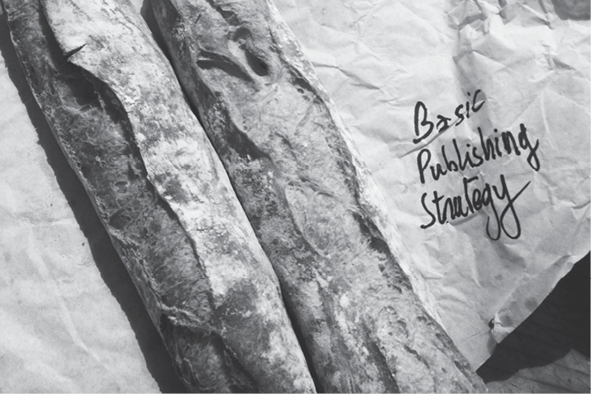
Flyer for the exhibition. Design: Basic Publishing Strategy
Dimitrina: In your practices you deploy temporally extended repetition and displacement. And in your performances you create continuous frequency environments of loops, resonances, and synchronicity that produce multiplicity for the duration of the performance and open up a space of collective aesthetic experience. What about your exhibition at Corner College?
Axelle: Repetition, yes. If I start from la chambre d’écoute (The Listening Room) – which is a painting by René Magritte depicting a green apple occupying the whole space of a room – then if I say I have been working with repetition, I want to stress that I don’t necessarily produce new content, or new objects. I have a principle in my work by which I reuse things that have existed before. I let them have their life, and just accompany their change of place which means changing the paths in which they become localisable and recognizable. When the place changes, the meaning enlarges. With my practices I try to occupy this very space of movement.
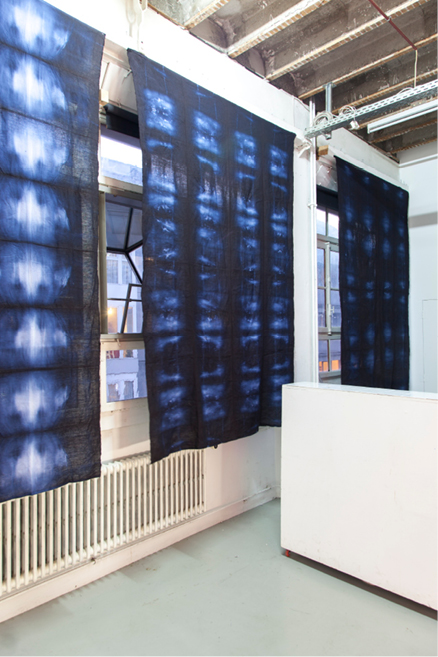
Axelle Stiefel, Das Herz, 2016. Exhibition view at Forde, Geneva. Photo: Etienne Chosson
There are elements of the exhibition I did at Forde in Geneva that I am interested in re-using for the exhibition project at Corner College. For instance the “curtains”, pieces of fabric I hung at the window of the exhibition space. Those large pieces of fabric are linen that I folded and dyed in blue indigo color. As I tied them with a rope and dyed them in the washing machine, they left a white trace. So you still have the mark of the fold that is behind it. I was intrigued, because the feedback I got after the show was, “I liked it. I could have liked it more without the piece of decoration.” I’m interested in how this perception can be destabilized. I think it has to do with the fact it was hung right in front of the window, though not in place of the actual curtains. It seems to me that the art viewer wants to recognize works of art. Perhaps they disregard what has an impact on the light, what gives an atmosphere, some elements that look like they have a function. They tend not to take them into account. They don’t perceive them as art. This has kept going on in my head that probably there is something I can change in the display, in a way that will further underline their presence in the space. Or through repetition. Whether I take them down from the window to the ground or across the space changes everything.
I’m still looking for a solution, for a way to prevent those pieces from being misperceived, to re-display, re-frame them somehow, without a frame, and define them more precisely. This is my starting point for my exhibition project la chambre d’écoute at Corner College. The thing I have been interested in is that the fabric has two sides. When you put them at the window you see one side from outside, and the other from inside. Even if there is some transparency, in the exhibition space the viewer forgets that it is two-sided, because they recognize it as an image, and look at it only from one of its sides.
How would I present the fabric pieces in order to make this double-sidedness, this back and forth active? I think of a circle that enables the fabric to stretch, but the fabric doesn’t have the shape of a circle. So if I make a circular structure and bend the fabric over it, there is still fabric all around it that is not part of the circle. And it can still move around. It doesn’t have the function of a frame, or a canvas on the wall. It can be suspended. It can be put on the floor. It can move, actually. It can take any shape, and still have a formal frame, the circle, or the fabric within the circle. So that would be a possible item, or character, in the exhibition.
Dimitrina: You used a tie-dye technique. A resist dye process, a bit like batik…
Axelle: Yes, exactly. I have one here that I can show you, if you want to see the fabric. It’s very modest, in and of itself, not something extraordinary. It has a certain heaviness.
Dimitrina: The intensity of the monochromatic color is striking. In itself, it gives this affective mood. It is so atmospheric.
Axelle: What I like in batik is that everyone has some basic knowledge of the technique. For certain people it’s more an ornament than art. It further refers to a trend in the 1960s-1970s related to the hippie movement.
Dimitrina: Regarding this back and front that you would like to make equally visible, it can be applied to the folding and unfolding process of its making, too. On the front and the back of fabric, you have the same quality of the image and intensity. Like in a plane or a Moebius surface that has no back and front, unlike a stamp or painting, which has only one side of representation confronting the viewer, while the other is an empty back of non-representation. Can the repetition of the patterns, how they remain uncolored, be seen as a kind of mark of resistance?

Axelle Stiefel, Le Fil Rouge (Contra punctum), 2016. Folded linen, lino printed, screen printed and dyed, hung on the wall
Axelle: I think one can feel the gesture that makes it. It’s really an imprint of a gesture, of an action, of a fold, of many folds. The immediacy, the readability of the gesture in the fabric is very interesting to me. And then, if I can stretch it over a circle – I have three other pieces of fabric –, the whole question is how I can bind them together. There is a technique of embroidery named Calado from Cartagena in Colombia, which originally is a method for embellishing wear in the fabric, to put back some regularity in a defect. It can be used to assemble pieces. I could imagine applying that technique. For the circle I’m thinking of material for building tents, arks, pieces you put together to make a tent. Those pieces are flexible. You can make an arrow, a line, but you can bend them to a circle, too. They could be connected to make the circle.
Dimitrina: Following your idea of the circle, what about the possibility to reverse what is the materiality of an image and what is a frame? As you make the circle you will inevitably get this shapeless kind of frame made of the fabric that remains around the circle. It would be like in making a map. It has to be framed by free space around it. When a three-dimensional form has to be represented in two dimensions, it always needs a frame, a part that remains outside of the representation. There is no cartography that is not framed by these empty spaces around it, a leftover that remains around the partial image, as a kind of ambiguous non-territory of material potentiality, or invisible support. If the map is a kind of two dimensional, flattened representation of a sphere, in a way like the fabric stretched in a circle, the opposite of this would be folding these two dimensions to produce a three dimensional body that is already embodied in the traces of the patterns.

Axelle Stiefel, Le Fil Rouge (Pile), ongoing series. Folded linen, lino printed, screen printed and dyed
Axelle: I hadn’t thought about that. But in a symposium about design research, I met a young woman scholar – Julia Mia Stirnemann – who had developed a program for generating new maps. These maps are an image of the Earth, but if you change your point of view, if you change the zero point and start for instance from Lucerne, if you make a new image of the world according to this new focal point, you get a different shape. You still have these borders, but the play of the border with the map of the world totally changes. She did this also to trigger our thinking, to displace our point of view and make us realize that things we take for granted are also in constant movement.
Dimitrina: The unframed surface of the fabric will move like the surface of a lake, something entirely contingent and shapeless. Without intending to necessarily make such a direct association between your idea about the fabric stretched in a circle and the title of your exhibition, it makes me think of the green apple that can really fill the entire space, and at the same time be a kind of silent hole, rather a blind spot or a quickly growing gap, like in René Magritte’s painting. Can the circle also be understood as a form that cuts transversally across the space of the room with another plane that opens up a hole to an ambiguous dimension?
Axelle: That’s exactly the point. And it’s also where the sound comes in. When you enter a space to do a performance, you have to work somehow on the environment, on the scenery – the views and the multiplicity of planes there. How can I create attention? What remains after the peak of attention? If I could have that kind of confrontation of something quite simple, but present, it could also be read in the light of the experience that can happen through the exhibition, or the performance, for example. It could really mirror what we do with sound, with words, sucked like the dye into the material of the fabric. It’s like a point of reference.
Dimitrina: Why did you decide on this indigo blue? Does impregnating the fabric with it have a symbolic dimension?
Axelle: At that time, I was thinking of the ocean, and that was the first color I linked to it. Water. Deep water.
Dimitrina: It makes me think about the imago, the Lacanian image stage and the mirror, though here it is a non-reflective mirror that is a kind of trap for the words, sound and gaze of disinterested attention. Deep water like in the ‘oceanic feeling’ of the Freudian pre-Oedipal mode of being. This blue ‘other’ jouissance – a disturbance that unsettles the boundaries of the self in the feminist poststructuralist psychoanalysis as a mystical beatitude beyond speech. For me this blue invites the viewer to experience a desire that calls the structure of the unconsciousness – the return of the object of desire petit a, these unconscious dreams/thoughts, and at the same time the patterns play the emergence of primary individuation, like in the so-called primitive lines in biology, produced by the folds or the process of interlacing, which here are the traces of the gestures of the rolling folds and knots, uncolored curls like the beginning of a consciousness or an inorganic structure that gains a kind of morphological aspect in itself, an interplay between chance and repetition in which certain patterns start to overlap and a structure occurs in it.
I think your idea of the circle of stretched fabric is a certain way of organizing a hole, which is already a kind of cut into the length of the fabric. Paradoxically, the circle emphasizes an empty space in the object-itself, an emptiness that is not there at first glance, an emptiness/silence that slowly opens itself up to the object’s surface and sucks in the gaze and the sound to reveal a gap that can alter, unsettle everything in the space, in a new becoming.
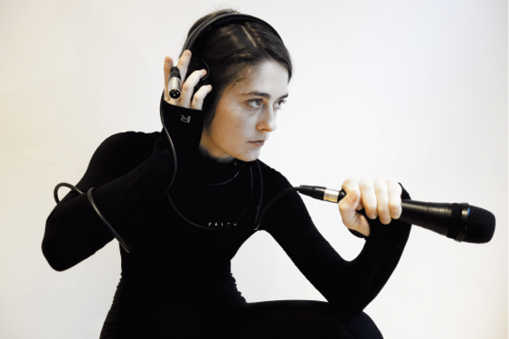
Axelle Stiefel, The Operator, 2016. Photo: Basic Publishing Strategy
Going back to repetition in your practices, at the Sympodium at Corner College you recorded and looped your own voice and breath, mirroring and overlapping these short sequences, branching them in a continuous displacement and parallelism, working with the different temporalities of the sequences. How did you involve repetition in your practices?
Axelle: I started using the word repetition at a certain point. I did my bachelor at ECAL, and they have a very specific use of repetition. But it tends to be tautological to me. I cannot go into details here, but I went through this education where the tradition is Neo Geo, Op Art, Minimal Art, etc. One advantage is that this education is formally rigorous. I understood that what we were proposed was a method. I learnt two things from it: one is how to manage the production, and the other is how to repeat. Put in a far too catchy way, it was as if we were told: the world can go round, but if you repeat, your work will travel with the course of the world. You can stay in one place, doing the same thing, and yet it will evolve with time. I get it, but it’s a risky bet. Let’s pretend time and space are a constant and a given. Right! I was actually interested in the other question: what produces time and space? But it was much more a way of saying we should bind our works to strong systems of reference. Perhaps it was meant to prevent from earthquakes, and we got one in 2008, though I’m not sure it helped considering the current state of art. The counter example was: if you don’t repeat, you can try to exhaust the repertoire of forms, but you have to compete with Armleder. Good luck! Behind it all, there is this whole idea of perpetual regeneration. It’s great but it’s an idea, more: its a fantasy. If you sign up to this, you deal with concepts of authorship – the signature, the genius – held together by belief systems, because something needs to remain after all. I am a woman! I’m an apparatus of reproduction by myself. I hope I have another destiny than ensuring reproduction. So, repetition: yes, but it needs another ingredient. In the meantime, I had become involved with performativity, where everything changes all the time. The parameters are not fixed, but the result of constant re-negotiations. It’s the reason why it’s difficult to trace my work over the years. I always take account of the people I interact with. I’m dealing with agencies. I grow with my experiences.
Then I came across the work of Elaine Sturtevant. I was really interested to discover that a woman was repeating the works of others. Not just any work. Those works of art which were recognized as being masterpieces in their own time, and instantly. It was not necessarily male artists. But just the synchronicity, the common statement that they were supported as masterpieces, relevant for art history. She didn’t want to do the same work. She just wanted to repeat. She just wanted to make them again. Perform the actuality of the work. Reintroduce the work in the continuity of its making. What I understood in that is the potential to be aware of what is around you, without being obsessed with the constant worry to produce and innovate. To be original. To realize your intention. It was like stepping into a process of understanding others, or the Other, by repeating as truthfully as possible, freeing yourself of your own intentionality, which sometimes blocks you from opening up. This repetition was interesting to me, as long as it was leading beyond an absolute of the image. It was bringing the image back in its effectivity, in its “working” and materiality.
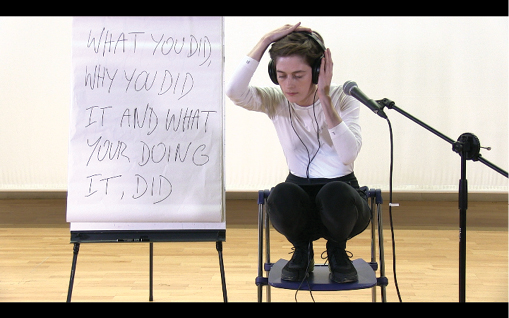
Axelle Stiefel, Performance, 2014. Performance Proletarians! Le Magazin, Grenoble. Video still
In the meantime, I found my practices between the realization of repetition, and how repetition came to me without my noticing, without my understanding it. From the tradition I come from, I had difficulties defining my own work, or my own standpoint. I was doubting whether I was really creative, or whether I was perhaps too literary, not necessarily a visual artist. I had difficulties also thinking my work, because I did not have the words at my disposal to think it through, and to generate new works. So I started collecting. Collecting materials from different sources. And those that would enlighten a little bit what I felt was my interest, or what I felt was something more than key words, formulations of artists about their own work, or the work of others. I was interested particularly about the whole literature around dance, around music, everything that is not verbal yet intimately bound to language.
Reading about Pina Bausch’s process, she gave an exercise to her dancers in which two dancers have to play together. One is in a fixed position and looks to the distance, and the other dancer goes exactly to this point the other is looking at. The dancer looking really fixes the point, and the other dancer moves into his direction. And because he fixes the point, the image of the other coming towards him is blurring. I was interested in those kinds of things, thinking of what they tell us, what they communicate, what exactly is the situation, what they talk about, what experience we gain in it? What I found out for myself is that Bausch was using this kind of exercise to free the dancers from preconception, of what it is to dance, what it is to tell a story, what they have to do, why they are here. The exercise was disruptive. The language close to bodily experiences was interesting to me. It’s like stuttering, trying to get close to meaning without fixing it. It’s really a quest. It’s transversal. It pushes. It’s a drive to move. It puts you in motion. This is where I found the potential in language. I thought, there are words that actually have this power. The way you put them, the sequence you create has this power.
And then, as I was more frequently invited to do performances than having opportunities to show works of art, exhibitions or installations, I thought it was interesting, from the position of a performer, to think that I am not necessarily moving, but I’m moving the others through speech, through words, through a sequence of words. Then, if the point, the target is to put people into motion, it starts already in how they receive the words, how they feel about them, what their relationship is to the meaning, to their expectation, the background.
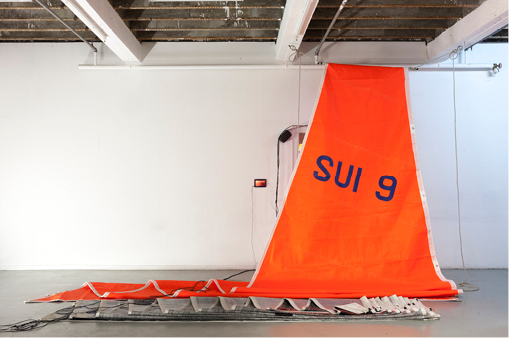
Axelle Stiefel, Das Herz, 2016. Exhibition view at Forde, Geneva. Photos: Etienne Chosson
I needed also to deal with the problem that is the identification of the spectator towards the performer. How can I draw their attention not necessarily on me, but also on themselves, on the room, on the people around them? I had to invent strategies, to prevent myself from dissolving into pure exhaustion, for example.
One of them was to smoke a cigarette. Smoking a cigarette had many functions for me. One is the breath. Breath puts the attention towards the atmospheric, the air. But it also directs the attention towards the inner self, because of course if someone breathes, you also become aware of your own breath, you somehow adapt. And then it’s also a rhythm, the rhythm of your breathing. It allowed me not to bother about what I’m doing, or what I’m talking about, or who are the people in front of me, but on this respiration. And then because I didn’t want it to be like a Yoga session, because it’s connoted to many other things, and I didn’t want to be that guru. I took the cigarette because it’s the antithesis of something healthy. It’s as if I have a purpose why I’m breathing, it’s because I want to smoke, because the cigarette wants me to smoke. It’s contradicting a little bit. And it’s helping me to stop my words. Because otherwise you stress them, and you read your text too quickly, say things too quickly so that people might never have the chance to catch up with what’s happening between them and the words you say. I was never trained. I’m not an actor. I just developed that to force myself to be conscious about time, and perhaps a bit about death, too. And the recording of it is there also to separate the source from what you are hearing, the source of where it is being produced, to have two lines working in parallel.
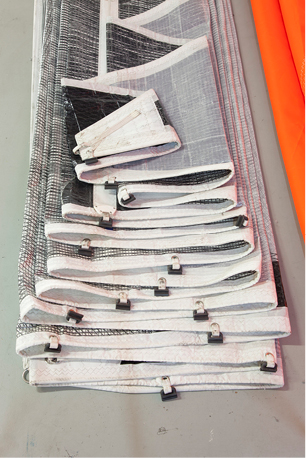
Axelle Stiefel, Das Herz, 2016. Detail at Forde, Geneva. Photos: Etienne Chosson
Dimitrina: In this simultaneity of the record and live, in the resonances of your voice, I see the performer as a communication medium to the outside whose presence in front of the audience is the message. You said that you have never been trained as an actor, and rather invented your strategy and method trough your practices. Did you work on your voice on your own to elaborate and modulate it further? I am asking because your voice sounds well trained and so beautiful. Did you record it to listen to it? Do you practice your voice in a kind of rehearsal routine as you work on a new piece?
Axelle: It’s very strange. I do it intuitively. I’m not a singer. I’m not an actor. I once had a roommate who was a hypnotist. She really had to train in order to get to this level, to control her voice. Maybe there is a deep desire in me to arrive at that point. When I was a child… now it becomes psychological. I can tell any story to explain this, and it doesn’t have to be true...
Dimitrina: I think a story is always about telling the truth by different means than naked facts, because the play of fiction is always about truth – a truth in-itself that may not correspond to facts. I am curious to hear your story about your voice.
Axelle: The voice is such an erotic element, a sensual element that it’s probably connected to very early stages of apprenticeship… Actually, no story is true enough to tell that! The cassette recorder with microphone was certainly a thing. I connected somehow the fact of taking the microphone, misappropriating words and addressing them, with a lot of pleasure and play. I also trained my ear as I studied classical guitar for nine years. Classical guitar is a rather quiet instrument, which meant developing the capacity to listen. I had a very good teacher. The guitar was a lifestyle for him, a philosophy of life. So, the questions of how you break the silence, how you enter with the sound, how the sound fades, were already brought to my attention as I learned to play the guitar. And the voice, I don’t know… Late at night, in bed, friends would ask me out of the blue: can you sing a song? Happened twice. And I would be totally shocked. I had no clue where it came from. Probably there was something in my voice that was calming.
Dimitrina: Do you think there is a space in the art scene for voice-based art works. Is there a context for an artist who works with performance based on voice and poetry?
Axelle: I find little space, actually. There are the loud ones. I’m not talking about them. There are my fellows. I had to find them in Brussels. But Brussels doesn’t know them. I think I’m just a little piece, as there are people who have gone much further on the journey into the voice than I have. I know my references, the ones I love the most. There is Robert Ashley. There is David Antin. There are writers also who are very good at reading their books, their texts. Pierre Guyotat in France is really someone whom I would love to hear reading. David Antin, I haven’t had the chance to hear him, apart from bits on Youtube. But I feel it already in their writing. It sounds, has a sound, a rhythm. They are writers for whom language sounds, in whose writing is a respiration, also. I think the experience of the potential of voice is generally quite low. I don’t think we are trained to be aware of that. Sometimes I go to performances and get annoyed, because it is given no attention. They use the voice as a tool to communicate, but they don’t take care of what this voice does. Sometimes it is contradicting what they are saying. It doesn’t support the same message, which I find annoying, because I hear that up front and cannot concentrate on the message, on what they want to say. I don’t care at that point. There is a materiality of the voice that I think should be worked through, should be deepened.
Dimitrina: This probably applies not only in an art context. The capacity and materiality of the voice can be used as an aesthetic tool that brings other nuances in our existence beyond the fixed meaning of the language. Even in daily life communication we can desire for people to be more conscious about their voice and its power, and how one can use it and its enormous possibilities for expression. I am wondering if awareness of the voice could be an aesthetics of daily life. Can you tell me about the relation between a text-score and the voice in your work?
Axelle: I’m not a big producer of text. Like everybody, I write e-mails. It takes a lot of my energy. I’m constantly worried, whether it’s in German, or English, or in French, I’m very sensitive to those changes. Writing is a suffering thing. It doesn’t go smooth as silk, as the expression goes. No, it occupies you. So sometimes I have a drive to write a poem, but it happens once in a year, maybe, that I write one. There are other necessities, other channels, different textualities.
The text I read is a cut-up of things I collected, and then I filled some elements with my own words, and it goes towards a situation. The writing has a purpose. It is about a place I imagine. And each time I repeat this piece of performance, of text, I reconnect to this place. And I get feedback from people, and think it’s still pertinent, still getting where I want. It’s not exhausted. And then I continue. I don’t necessarily write new text material, but I retrace what is there, repeat it, and incorporate readings. And in the way I edit them in the course of performing it over and over again, they change the performance. I usually show a part of it, but I can stretch it to one hour and a half. And then it’s not my text, necessarily, but the texts of others, cut in a way in which sometimes the sound is the element of binding, or silence is a cut, or it is words that connect. There are different levels that enable this continuous breath to keep on. Those texts come from my personal readings, texts that enlighten my present experience, or my work, or the present times.
For example, at the end of my performance, there is a poem by Wallace Stevens, The Woman That Had More Babies Than That, a poem about the movement of the sea, its repetition. It echoes what I put in the first place, and it can come back in another form after. For example, the sound of a tuning machine that I use, repeats the breath that echoes the text. The text goes down. The sound comes up. Maybe a recording machine makes an appearance. I have voice mailboxes that I use that interfere at some points. And then I have my machines, which I didn’t bring this time, but which help me bring attention to the fluctuations of the voice, of the meaning. They make a resistance to what I say, what I intend to say. They suddenly distort it. I use that to get in dialog.
Dimitrina: These machinic disturbances distort and at the same time support other interactions between your voice and you-the-other-voice, a kind of self-possession and self-presence that troubles. At the same time it is a disposition of liberation from the self, a trembling temporal existence of intensity that has the capacity to become consistent, the voice that echos the Other. Mladen Dolar in his essay What’s in a Voice wrote: “The voice as resonance is the opposite of self-presence: it is a reflexivity, a return, but which doesn’t imply an identity or a self-presence, and in that very dislocation it is the opening of subjectivity. It is not the same subject which sends her message and gets the voice bounced back – rather, the subject is what emerges in this loop.” You said that when you write it is unproductive, slow. Then I think about the technological aspects, the machinic modulations that actually give this slowness ‘accelerated infinite speed.’ Do you always work with a script for your performances?
Axelle: Yes, there is a script. I don’t improvise. Because if I do, I put all my attention on my skills, the skillful way of playing music, or of creating something authentic, unique, not on the performative process itself.
Dimitrina: Which is connected to what you said about working with repetition in-itself. Even if you don’t see yourself in the tradition you came across in your education, I find a certain affirmation of it in your work. If you have a script, you can copy, you can repeat, and you don’t need to be creative/inventive every time, because your intention in every repetition is not authenticity, but contingency and process. Then you can be even more creative at every performative moment of the performance, because you can open this gap in which you can really let the metamorphoses happen, this empty moment that makes the presence uncompleted and fragments the duration of the performance. The scattered pieces evoke this other time yet to come, the multiplicity that moves the audience without movement. And the voice loses its uniqueness, like in Beckett.
Is it an exercise of slowing down, a collective timeless mediation for the audience? With regard to this, I am wondering how you reflect on language, how it interplays in this kind of contemplative performative situations that create moving waves for the duration of your performance. What kind of artistic material is language? Is it part of this displacement and transition related to the concept of change. You say that the artist can do things with words. Is there a situation in which language can escape the mode of communication? In which language, like in poetry, can be reactive, autonomous or even cryptographic. It can produce, as you said of the relation between breathing and rhythm, an antithesis, like smoking a cigarette, that can by a negative space. Your smoking a cigarette in your performances evokes in my mind an image from another painting by René Magritte, the 1934 close-up portrait of the slender face of a young and beautiful woman smoking on the background of a sky with clouds.
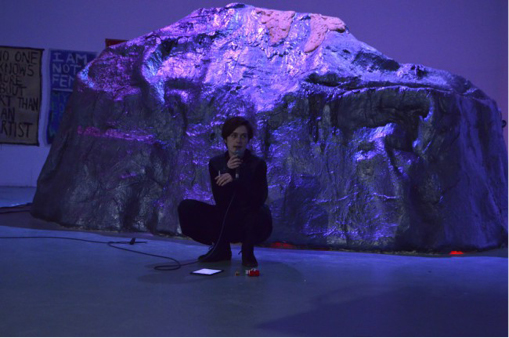
Axelle Stiefel, Performance, 2015. At The Feminist Rock Salt Presents by Deniz Unal, Anna Maria Pinaka, Diana Policarpo. Exhibition Does Not Equal, W139, Amsterdam
Axelle: I’m not a constant observer of what I do with language. My relation to language as a material is that it is not something I master. It’s not something I possess. It’s something I have always to acquire. I was bilingual as a child, until the age of seven. Since then, my mother tongue has taken over. Until seven I was bilingual, which means that sometimes I was not understanding, I was not mastering one language. It was not obvious. I was moving between two languages, and also there was a lot of English around me. Friends of my parents. I knew there was yet another world. The sonority of words, and how they were accompanied by body language, was the first perception that constructed my relationship to language. Then, the social pressure of mastering the language was the second step. The violence of language. The fact of being excluded because you don’t understand the expressions. When I arrived in Lausanne, I was the Swiss German girl. Although French is my mother tongue, I was always late understanding a joke. I was not good at memorizing names. I very quickly went into being systematically aware that I could sum up a book, but I could not go into the details. I could not explain the definitions of words, but I knew what they were doing.
Dimitrina: It seems you sensed the overall situation, without being able to translate it precisely into words.
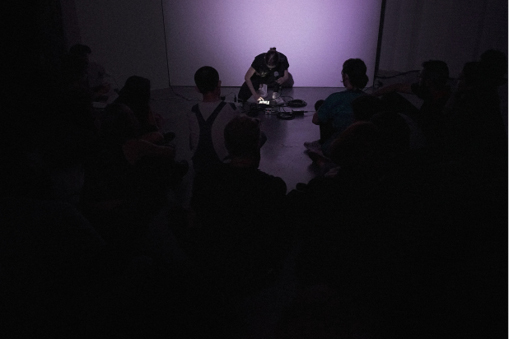
Axelle Stiefel, Reading in Width of a Witch by CA Conrad, 2016. At Idioletta by Costanza Candeloro and Mattia Capelletti. O’, Milan. Photo: Anna Adamo
Axelle: Translation was an important part, which I was unable to define. If I had to explain something, I had to tell another story, to enlighten the content. Then in the specifics of the work, I think it’s really about the power of images through the words. They are images in themselves. There is a graphy. It depends who you read, what you read. But some writers are especially aware of which words they pick up, the roots of those words, and the oscillation of meaning. A word will take on another meaning, vibrate differently, depending on where you put it. It has to do with erotics, with the flesh. Franco “Bifo” Berardi did a talk about the erotic body of the political movements. Some things he says really ring true. As when he asks where the next generation will learn language from, on the backdrop of semiotic capitalism and its semiotization of our daily life existence. Probably the Internet and other tools, the machines provide information and content and data that no longer necessarily need to be transmitted by way of the family, as a first structure, or the mother, or any other that is a substitute, or embodies the language, that will transmit the feeling of care, love, or fear, the affect. This relationship of affection, being affected, affecting others, is really something I think about with words.
Dimitrina: Your reference to Bifo reminds me of the GPS units in cars with their artificial robotic voice that gives the direction: “Take a left!,” “Take a right!” It’s so unpleasantly synthetic that it completely destroys my attention. At information desks at airports, train stations and other non-places or heterotopian spaces, the human voice is frequently replaced, and the information delivered by roboticized programs and their machinic voices. These artificially created voices often sound female with an exaggeratedly sexy presence, an erotic undertone. Going back to your practices, you said you decide on certain words because they have a special sound for you. Do you have a method when you start playing with different combinations?
Axelle: The material is also life experience. I am often inspired by a book I read, even if I am no longer a bulimic consumer of literature. I am very much constructed by literature, and until the age of twenty my practice of reading was very coherent. Then I realized that I had to cope with other elements of reality, too. Other languages I didn’t understand. The idea of cohabiting with words over a longer period of time without worrying about whether you understand them or not, that is exactly what poetry does. It’s not graspable at first, at once. But you can carry it with you for a very long time. You remember poems that you learned in school. Or even better, songs. You’re also sort of singing when you read a poem out loud. Those words are like luggage that you carry with you. It also has to do with being a migrant in your own language, or being in-between languages, be it in your own country or another, so these words become very important. I came to select the words that I felt I wanted to spend time with.
Dimitrina: I’m intrigued by your statement that you don’t master the language, that you don’t possess language, but it possesses you as it transversally passes through you, and about the feeling of being foreign or minor in your own language. Trying to imagine other models, a utopia where bare life is driven by a different economy not based on possessive individualism, touching language not only as a means of communication and exchange brings another modality of being-in-common that is inherent in language, the commoning and participation in an infinite conversation. This is an economy of being-in-common as sharing and partaking, not as an exchange and market value, what Maurice Blanchot called the workless community and its literary communism, or let’s rename it literary commoning, being suspicious of the commune. Language in-itself is one of the rare things that remains for free. At least we do not pay taxes to use it. At the same time, it’s such an expensive material, because we labor it, we work on it, we produce it, we have to learn it. It takes great effort, and then in-itself it can be given and taken for free.
Axelle: Completely agree. Today I had my course in branding design. I have this specific, singular relation to language in which my body is engaged. And then I listen to people, specialists, talking about how I should structure, how I should create value, hierarchies between words, to capitalize my capacity of shitting words, so to say. To some people in the classroom, these methods may provide a way to start engaging with words, a basis to step on. But you just see how the entire economy has shifted the attention to those specialists who own the words, apparently. They are owners. They are the experts. They are the consultants. They tell enterprises how to manage their image better, and their image starts with the words. It starts with the values assigned to them, and those values are truthful, authentic. Authentic comes up all the time. And creative.
Dimitrina: Quite the opposite of your own artistic approach and practices. The authenticity of the cliché, precisely what you need to get rid of in order to be really creative in the uniqueness of your voice.
Axelle: It’s a total emptying of meaning. It makes it a currency.
Dimitrina: And the currency is a medium of exchange, but unlike language it does not of itself carry meaning, or any breathing affect. The financial industry managed to frame its circulation such that money would produce meaning by itself, and even shape nature. But unlike language, it is not a live force that gives meaning, a breathing space of the voice – it is death.
Do you have any research references to some of the great women artists who worked especially with textile material and language? I mean Tracey Emin, for example, the first that comes to my mind, and all her experimental work with textile and language, in-between performance, objects and site specific installations, in embroidery and furniture, patchwork and strong political messages. I mean her chairs, tents and banners, and folding and unfolding these materials, the fabric and words. And Louise Bourgeois’ particular relation to textile that has a strong political and psychoanalytical aspect. And Rosemarie Trockel gains in the relation between the textile and the sign, with the playboy works, which she actually ordered in a factory. In her case they are not handmade but machinic, and the women artists from the second wave of feminism… I think it’s such a rich field that is interesting to explore and of course there are so many other rather young artists who work …
Axelle: I picked up the thread, so to say, of textile, of fabric, because I realized it’s so much connoted, in very different ways, to the religious, the feminist, the domestic, to relics, memory.
Dimitrina: I am quite interested in all this aspect, as well, and in the historization of textile from the domesticity of women to the industrialization of domestic work, and then to its social and political impact in the globalized economy, like how the textile industry is part of the dirtiest exploitation in the Third World and everywhere, even in the so-called developed countries, and then the history of resistance and struggles of the laborers involved in this production.
Axelle: Exactly! It has something to do with precarity. I read about embroiders from Cartagena in Colombia, where women embroider pieces of linen that have defects, and they do this point which is called calado, which was investigated by a sociologist of science and techniques. Over the past ten years there has been a growing interest in textile, because it has continuously been quoted as a metaphor for things we do on a much more immaterial level. It’s a good metaphor for ethnographic explorations. And it’s a good metaphor for me as a performance artist, too, because I could call myself a weaver of the real. What embroiders do, actually, is accompanying work, something they do beside other activities. When they are finished washing, they have time to get back to embroidery. It’s a way to resist…
Dimitrina: … and to mediate the space between them and the outside in order to be able to resist and struggle?
Axelle: Yes. Or to have indirect exchanges with people. I recently went to a show of two women artists, Marion Goix and Lin Vorwinzel, at Espace Quark in Geneva. They decided to occupy the space. Their proposition was to inhabit the space for a month. They built a beautiful structure, little houses inside the space, along with a couple of works on display that all have to do with the experience of time, of a very vernacular practice. I arrived in the space. I didn’t research anything. I just trusted them, went, as I was invited to spend a night with them in the space. I arrive. It’s dark. There are candles, and there is a woman embroidering something on a piece. I thought, that is really strange. Because I’m reading about it. I want to learn it. And there it happens. I had to be invited to spend the night with those two girls in an art space to actually get closer to this experience I was looking for. Which is just sitting at the table. She is concentrating on making her line, which she tells me is her duty of the day. And we talk, about other things. And as we are talking, she embroiders.
Dimitrina: And she is able to do this while talking?
Axelle: Yes. She said it took her a bit of time to get to this point.
Dimitrina: It’s just quite a challenge to do all of these things well at the same time. As one dissociates the listening and talking from the activity of the hands, split the attention between the two, I think that would open a gap. This kind repetition for itself, an interval between two differences, it seems to me, is also what you have been looking for in your practices and work, to create a discrepancy between the different activities, to open up a gap and make space for an event to take place and probably get to a deeper state of both of them, a deeper stage to make the audience see/view and listen to this emptiness and silence in order perhaps to be moved to meet their own creativity.
Axelle: I have to try. It’s really that your hands know. And you’re able to be concentrated and distracted at the same time. The work you’re doing with your hands is like the passing of time.
Dimitrina: It’s repetitive, but at the same time, as far as I know, they have to count. Every stitch requires precision and attention. If you engage the needle one thread to the wrong direction, it takes a lot of effort to correct it, to carefully remove the thread and start over. It amazes me how one can have such a concentration, and then be able to be part of intensive conversation.
Axelle: Yes, they have to count. I think it’s also a way to survive. Am I wrong? I mean… we of course, project about…
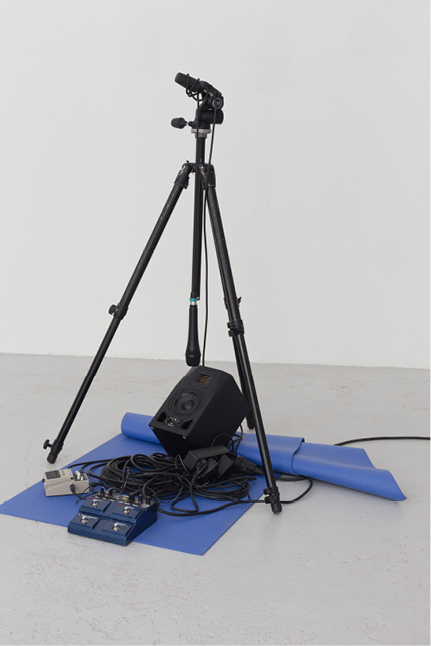
Axelle Stiefel, Fantasma, 2015. Sound piece with looper, microphone, tripod, sound monitor, equalizer and mat. Komplot, Brussels. Photo: Jakob Argauer
Dimitrina: For me it can be grasped as a kind of escapism of a collective subject, practices in which a thread or a line of escape can operate virtually. At least historically, when in the past women were kind of enslaved in a situation where they were domesticated through textile. At the same time, it was their own way of finding the capacity to resist and jump into the rabbit’s hole to the outside of their own interiority through the simultaneity of the rhythm of the hand work and the workless infinite conversation, of running away at the limit of their own existence to the infinite dimensions of their impossible freedom. And probably of empowering each other to transfer and distribute power relations and violence across layers, like facing an abusive husband who is not able to say anything meaningful and is rude to them, plus the whole routine endless heavy home work and in parallel to these, creating beauty, repairing, preparing, repeating, giving consistency to the existence to be able to take care and love. In The Second Sex, Simone de Beauvoir is very critical of the idealization of these kinds of craft. She says it looks beautiful, but when you think about its context and the (unpaid) price of the desperate labor involved, it’s so heavy and disgusting. But I suppose nowadays it might be different, the crafts are liberated to the extent that they can be seen in a different plane, even as a weapon/device of women artists against the male dominated normative discourse in high art.
Axelle: It’s disgusting in the same way. Maybe it’s not her husband, because the violence is somewhere else. It’s much more diffuse. Still, the domestic still exists. And the home remains a powerful way of submissions and domestication of the women.
Dimitrina: When you mentioned the home, it reminded me of a feminist artist from the 1970s who was working a lot with embroidery, Elaine Reichek. Her technique is very crafty. Do you know her work? For instance Sampler (Home Sweet Home, Kilmainham), 1992, an embroidery on linen. It’s part of her Home Sweet Home series inspired by the disciplinary line of the home, prison and museum. Kilmainham was a notorious prison in Dublin, now turned into a museum. Reichek is one of those artists who researched these old techniques through a very conceptual and political agenda, and incorporated them into her practices.
Axelle: You can sense this tension in the textile departments at the Art Universities, where there is a struggle between the beauty and utility of industrial production. Like in pattern making. Almost painting. Making motifs. Repetition. Almost giving oneself to an industry without questioning. One needs to see the piles of drawings on sale in fairs. Corridors of random stuff accumulated. What is the history? What is the background? Where does it come from? Where does it go? How can one be exploited in doing that? It’s tempting to cocoon oneself. On the one hand it is desirable, because it’s fulfilling, but on the other it’s scary, because it’s not in tune. It flirts with fear. It stirs disengagement.
